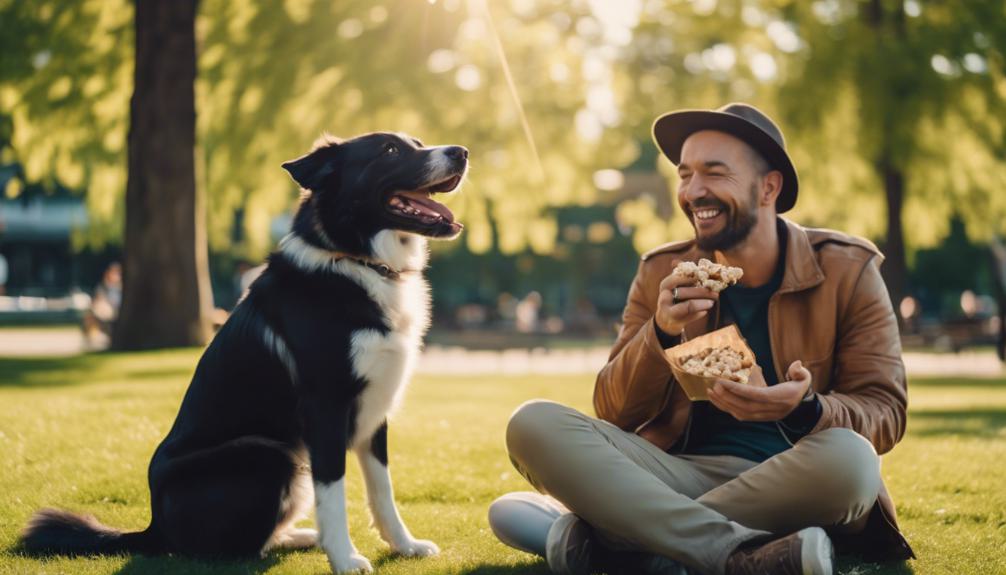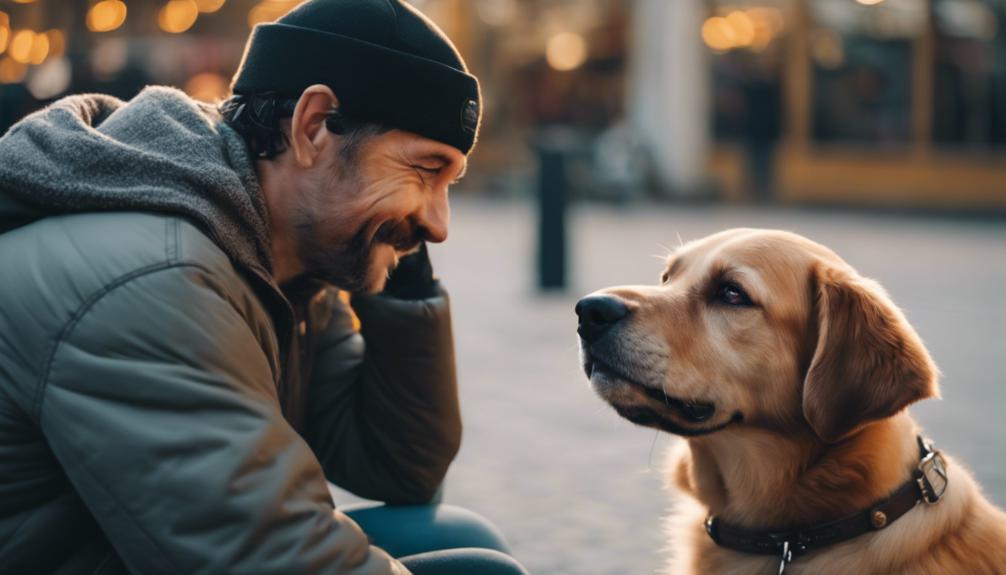How to Train Your Dog to Be Friendly with Strangers? Pro Tips
To train your dog to be friendly with strangers, start early socialization before 3 months old. Teach positive greetings using treats and praise. Expose them to various settings and people gradually. Focus on calm sitting during introductions. Reward good behavior to associate strangers with positivity. Set clear expectations and use consistent rules. Control exposure to new people in a controlled way. Watch their body language and reward friendly behavior. Seek professional guidance if needed. By applying these techniques, your dog can learn to be more friendly with strangers and enhance their social skills further.
Early Socialization Techniques
To help your dog become comfortable with strangers, begin socialization before they turn 3 months old. This stage is critical for training. Teach your dog to greet new people using positive reinforcement. Expose them to different settings, sounds, and people to boost their social skills. By controlling their exposure to new situations, you can lessen their tendency to get overly excited. It’s important for both your pet and your guests to know what’s expected during their interactions. Such early training lays a strong foundation for good manners and positive behavior around strangers. Consistent, positive experiences during this important time can significantly shape your dog’s ability to interact socially as they grow.
Try introducing your dog to various environments, like parks, busy streets, and calm suburban areas. This variety helps them adjust to different levels of noise and activity. Remember to keep each new encounter short and positive. Use treats and praises to reward calm and friendly behavior. Doing so reinforces good habits.
What you do now can influence your dog’s future behavior. Keep each session enjoyable and stress-free, for the best results.
Proper Greeting Training Methods
To teach your dog proper greeting methods, focus on having them sit calmly when meeting new people. This prevents jumping or lunging. Reward your dog with treats and praise whenever they greet someone politely, reinforcing their calm behavior.
Practice greetings with a variety of people to help your dog make positive connections and generalize their good behavior. Ensure your dog knows basic commands like ‘sit’ or ‘stay’ before they meet new people.
Consistency and patience are crucial for training your dog to greet strangers in a friendly way. Create a positive association with meeting new people to make your dog feel more comfortable and confident during these interactions.
Positive Reinforcement Strategies

Using positive reinforcement is an effective way to teach your dog to be friendly with strangers. Here are practical tips to help you reward your dog and encourage positive behavior:
- Reward Calm Behavior: Reward your dog with treats or praise whenever they act friendly towards strangers. This helps reinforce good behavior.
- Associate Strangers with Good Things: By rewarding your dog, they’ll start to connect meeting new people with positive experiences, making them more likely to be friendly.
- Build Confidence: Regular rewards when your dog interacts with strangers boost their confidence and trust, leading to friendlier behaviors.
- Create Positive Associations: Over time, positive reinforcement helps your dog form a welcoming attitude towards meeting new people.
These strategies are straightforward and effective for promoting friendly interactions between your dog and strangers.
Controlled Exposure to New People
To ensure your dog is comfortable around new people, it’s crucial to expose them gradually and in a controlled setting. Start with people they already know before meeting strangers. This method helps your dog become familiar with the process and reduces their stress.
Watch your dog’s body language and behavior closely during these introductions. Use treats or praise to reward your dog when they behave calmly and friendly. Make sure they don’t feel too overwhelmed during these sessions.
Regular and patient introduction to various people will boost your dog’s confidence and create positive associations with new encounters.
Setting Clear Expectations

To transition your dog to comfortably meeting new people, it’s crucial to set clear expectations. Here’s how you can train your dog to interact positively with strangers:
- Define Expected Behaviors: Specify what actions you want your dog to take when meeting new people. For example, sitting calmly or wagging their tail.
- Consistent Rules and Boundaries: Maintain the same guidelines for how your dog should behave around strangers every time. This might mean no jumping or excessive barking.
- Communicate Expectations: Make sure that others who interact with your dog know these rules. This consistency helps your dog learn faster.
- Positive Reinforcement: Reward your dog with treats or praise for following these behaviors. This encourages them to repeat these actions in future interactions.
Addressing Unwanted Behaviors
To tackle unwanted behaviors in your dog when meeting strangers, it’s important to find out why they react the way they do. Dogs might bark, lunge, growl, or snap because they’re scared, anxious, or not used to people.
Start by slowly getting your dog used to being around strangers in a controlled setting. Use treats and praise to reward them for calm and friendly actions. Keep up with this training regularly and always reward good behavior to help change how your dog acts over time. Watch your dog closely to see how they feel and react.
If your dog keeps showing these behaviors or if they get worse, you might need to get help from a professional trainer. Building your dog’s trust and confidence is crucial for better interactions with strangers.
Building Confidence Through Training

Training your dog with positive reinforcement is key to boosting their confidence with strangers. Here are effective steps to follow:
- Reward Calm Behavior: Treat and praise your dog when they stay calm around new people. This reinforces good behavior.
- Gradual Exposure: Acquaint your dog with strangers slowly and in a place where you can control the situation. This helps them get used to new people without stress.
- Obedience Commands: Teaching your dog basic commands helps you manage their behavior in social settings. Commands like ‘sit’, ‘stay’, and ‘come’ are essential.
- Keep Your Dog on a Leash: Always use a leash when introducing your dog to strangers. This ensures safety and control over the interaction.
These straightforward steps can significantly enhance your dog’s confidence when meeting new people.
Seeking Professional Guidance
If your dog is shy around strangers, it’s a good idea to seek help from a certified dog trainer or behaviorist. These professionals specialize in helping dogs overcome fear and improve social skills. They’ll watch how your dog behaves and create a training plan that fits just right. This plan may include safe and controlled meetings with new people, which helps your dog learn to be less afraid.
Training with a professional means using proven methods to tackle the root of your dog’s fear. This approach not only boosts your dog’s confidence but also helps them form positive feelings towards meeting new people. Getting expert help is crucial for effectively changing your dog’s behavior and making them happier and more self-assured when they meet strangers.
Frequently Asked Questions
How Do I Train My Dog to Accept a Friendly Stranger?
To train your dog to accept a friendly stranger, start with gradual exposure and positive reinforcement. Use obedience commands, rewards, and consistent training. Over time, your dog will build confidence and become more comfortable around strangers.
How Do I Stop My Dog From Being Aggressive Towards Strangers?
To stop your dog from being aggressive towards strangers, identify the triggers causing fear or anxiety. Seek professional guidance to address underlying issues. Use positive reinforcement techniques. Provide a safe retreat when overwhelmed. Consistency and patience are key in modifying aggressive behavior towards strangers.
Why Is My Dog Not Friendly With Strangers?
Your dog may not be friendly with strangers due to genetics, past experiences, or lack of socialization. Fear, anxiety, or feeling overwhelmed can also contribute to unfriendly behavior. Recognizing these reasons is essential for effective training and behavior modification.
How Do I Teach My Dog to Be Friendly?
To teach your dog to be friendly, use positive reinforcement with treats and praise. Gradually expose them to different people in controlled settings, teach obedience commands, and practice desensitization. Seek professional help if needed for fear or aggression issues.
Conclusion
To train your dog to be friendly with strangers, start with early socialization. Introduce your dog to different people from a young age. Teach proper greeting behaviors, like sitting instead of jumping.
Use positive reinforcement; give treats or praise for calm behavior around new people. Gradually expose your dog to various social situations under control.
Set clear rules about how your dog should behave with strangers. Correct unwanted behaviors, such as barking or growling, immediately. Confidence grows through consistent training.
If needed, get help from a professional trainer. Be patient and persistent. Over time, your dog will likely respond to strangers with a wagging tail and calmness.

